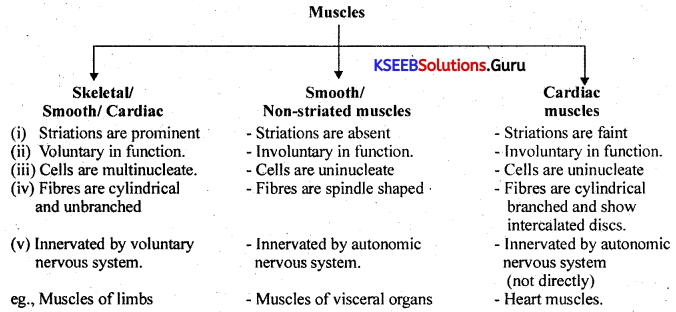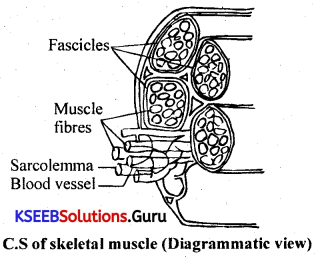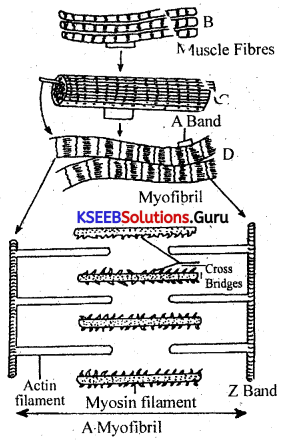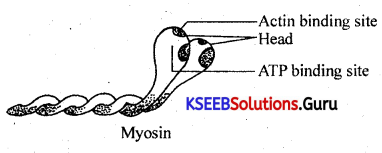Karnataka 1st PUC Biology Question Bank Chapter 20 Locomotion and Movement
1st PUC Biology Locomotion and Movement One Marks Questions and Answers
Question 1.
What is gout?
Answer:
It is the inflammation of the joints due to excess accumulation of uric acid. It is associated with an inborn error of uric acid.
![]()
Question 2.
What is Arthritis?
Answer:
It is an inflammation of joints.
Question 3.
What is Osteoporosis?
Answer:
It is all age dependent disorder of the bones, characterised by low bone mass, deterioration of the microarchitecture of the bone and increased fragility.
Question 4.
What is Myasthenia gravis?
Answer:
It is an auto-immune disorder, affecting the neuromuscular junction leading to progressive weakening and paralysis of skeletal muscles. It is caused due to non-transmission of nerve impulses due to non-functioning of acetylcholine.
1st PUC Biology Locomotion and Movement Two Marks Questions and Answers
Question 1.
Write the differences between the following:
(a) Actin and Myosin
(b) Red and White muscles.
Answer:
(a) Actin (Thin) filament: length is about 1.0 mn and breadth 9 nm globules
- Actin filament contains three proteins namely active (F-actins and G-actins), tropomyosin
and troponin. - Each actin filament consists of two F (filamentous)-actins, that are helically wound to each other.
- Each F-actin is a polymer of G-globular actins.
- Two filaments of tropomyosin also run close to the F-actions throughout their length.
- Troponin is a complex protein found at regular intervals on the tropomyosin.
- In the resting state, a subunit of troponin masks the actin-binding site of myosin.
Myosin (Thick) Filament: length is about 1.6 nm and breadth the 15nm.
- Mysin is a polymeric protein, whose monomeric proteins are called meromyosins.
- Each meromyosin has two important parts, a globular head with a short arm and a tail.
- The head with the short arm is called the heavy meromyosin (HMM) and the tail is called light meromyosin (LMM).
- The HMM component projects outwards at a regular distance at an angle from the surface of the polymeric meromyosin; it is known as a cross arm.
- The globular head functions as an ATPase enzyme and has the binding sites for ATP and active sites of act.
![]()
(b)
| Red muscles | White muscles |
| (i) They have high quantity of myoglobin, which makes them red in colour. | (i) They have very little of myoglobin and are not red in colour. |
| (ii) These are thinner. | (ii) These are thicker. |
| (iii) They have a number of mitochondria and blood capillaries. | (iii) They have less number of mitochondria and less blood capillaries |
| (iv) Sarcoplasmic reticulum is less. | (iv) Sarcoplasmic reticulum is more. |
| (v) They can work for longer periods without getting fatigued. | (v) They work for shorter periods and get fatigued. |
Question 2.
Name the cells / tissues in the human body, which
(i) Exhibit amoeboid movement
(ii) Exhibit ciliary movement
Answer:
(i) Amoeboid Movement: Macrophages and Neutrophils.
(ii) Ciliary Movement: Epithelium of nasal tract, urinary tubule and fallopian tube.
Question 3.
Locomotion requires a perfect coordinated activity of muscular, and … system.
Answer:
Skeletal, neural.
Question 4.
What tissue is affected by myasthenia gravis? What is the underlying cause?
Answer:
Tissue affected by Myasthenia Gravis is Muscles. Cause. Non – stimulation of muscles by nerves due to the auto immune destruction of Na channel protein, so that muscles become weak and the patient suffers from paralysis.
Question 5.
Write true or false. If false, change the statement so that it becomes true.
(a) Actin is present in thin filament
(b) H-zone of striated muscle fibre, represents both thick and thin filaments.
Answer:
(a) True.
(b) False : H-zone is light zone of A-band where thin actin filaments are absent.
(d) False: There are 12 pairs of ribs.
![]()
1st PUC Biology Locomotion and Movement Three Marks Questions and Answers
Question 1.
Define sliding filament theory of muscle contraction.
Answer:
In humans, the muscles are broadly classified into three categories, as given below:

Question 2.
Describe the important steps in muscle contraction.
Answer:
About 40-50% of the body weight of an adult human is contributed by muscles.
- Muscle is a specialised tissue, that arises from the mesoderm.
- Muscles show special properties like excitability, contractility, extensibility and elasticity.
Muscles have been classified using criteria like
(i) location,
(ii) appearance/morphology and
(iii) nature of regulation of their activities.
1st PUC Biology Locomotion and Movement Five Marks Questions and Answers
Question 1.
Draw the diagram of a sarcomere of skeletal muscle showing different regions.
Answer:
In humans, the muscles are broadly classified into three categories, as given below:

![]()
Question 2.
How do you distinguish between a skeletal muscle and a cardiac muscle?
Answer:
Skeletal muscle
- An organised skeletal muscle is made up of a number of muscle cells/fibres grouped into bundles called fascicles.
- The fascicles are held together by a collagenous connective tissue layer called fascia.
- Each muscle bundle has a number of muscle fibres/cells.

- Each muscle fibre has a membrane called sarcolemma that encloses the cytoplasm called sarcoplasm.
- The sarcoplasm contains mitochondria (sarcosomes), endoplasmic reticulum (sarcoplasmic reticulum) and many thin parallelly arranged filamentous or rod-like structures called myofibrils.
- Each myofibril has throughout its length, alternate dark and light bands, that are responsible for the striated appearance of the muscle.
- The light bands contain actin and are called 1-bands. (isotropic bands).
- The dark bands contain myosin and are called A-bands (anisotropic bands).
- Actin filaments are thinner (hence called thin filaments) and myosin filaments are thicker (hence called thick filaments).

- In the centre of the 1-band is an elastic fibre called ‘Z’ line, to which the actin filaments are firmly attached.
- The thick filaments of the A-band are also held together in the middle of this band by a thin fibrous membrane called ‘M’ line.
- The portion of the myofibril between two ‘Z’ lines is a sarcomere, the functional contractile unit.
- In resting stage, the edges of the thin filaments on either side of the A-band (thick filaments) partially overlap the free ends of the thick filaments.
- The central part of the A-band (thick filament) not overlapped by thin filaments, is called the H-zone.
Cardiac muscle:
Cardiac muscle tissue is one of the three types of muscle tissue in your body. The other two types are skeletal muscle tissue and smooth muscle tissue. Cardiac muscle tissue is only found in your heart, where it performs coordinated contractions that allow your heart to pump blood through your circulatory system.
![]()
1st PUC Biology Locomotion and Movement Text Book Questions and Answers
1. Movement And Locomotion:
- Streaming of cytoplasm in the unicellular organisms is the simplest form of movement.
- Animal cells also show movement of cilia, flagella and tentacles.
- Animals move their body parts like limbs, jaws, etc.
- Walking, running, flying, swimming etc. are different forms of locomotion.
- In Paramoecium, cilia help in movement of food into cytopharynx and also for locomotion.
- Hydra uses the tentacles for food capture as well as for locomotion.
- Human beings use the limbs to change the posture of the body as well as for locomotion.
2. Types Of Movement:
Cells of human body show three basic types of movement:-
(i) Amoeboid Movement/Pseudopodial movement :
Macrophages and leucocytes exhibit amoeboid movement. It is also seen in amoeba. Amoeboid movement is effected by pseudopodia formation by cytoplasmic streaming. It also involves cytoskeletal elements like microfilaments.
(ii) Ciliary Movement:
These movements are caused by fine versatile hair called cilia.
Ciliary movement occurs in those hollow tubular visceral organs, that are internally lined by ciliated epithelium.
Ciliary movement in trachea helps in removing foreign substances or particles.
Ciliary movement in fallopian tube causes the ova to move to the uterus.
(iii) Muscular Movement:
The contractile property of muscles is responsible for muscular movement.
Movements of jaws, limbs, eyelids etc. are muscular movements involving striated muscles.
Movement of food in the alimentary canal and movement of urine in ureters are movements involving smooth muscles.
(iv) Flagella movement: It is caused by long whip-like process called flagella. It is seen in spermatozoa, euglena and sponges.
Muscle:
About 40-50% of the body weight of an adult human is contributed by muscles.
- Muscle is a specialised tissue, that arises from the mesoderm.
- Muscles show special properties like excitability, contractility, extensibility and elasticity.
Muscles have been classified using criteria like
(i) location,
(ii) appearance/morphology and
(iii) nature of regulation of their activities.
![]()
In humans, the muscles are broadly classified into three categories, as given below:

Skeletal muscle
- An organised skeletal muscle is made up of a number of muscle cells/fibres grouped into bundles called fascicles.
- The fascicles are held together by a collagenous connective tissue layer called fascia.
- Each muscle bundle has a number of muscle fibres/cells.

- Each muscle fibre has a membrane called sarcolemma that encloses the cytoplasm called sarcoplasm.
- The sarcoplasm contains mitochondria (sarcosomes), endoplasmic reticulum (sarcoplasmic reticulum) and many thin parallelly arranged filamentous or rod-like structures called myofibrils.
- Each myofibril has throughout its length, alternate dark and light bands, that are responsible for the striated appearance of the muscle.
- The light bands contain actin and are called 1-bands. (isotropic bands).
- The dark bands contain myosin and are called A-bands (anisotropic bands).
- Actin filaments are thinner (hence called thin filaments) and myosin filaments are thicker (hence called thick filaments).

- In the centre of the 1-band is an elastic fibre called ‘Z’ line, to which the actin filaments are firmly attached.
- The thick filaments of the A-band are also held together in the middle of this band by a thin fibrous membrane called ‘M’ line.
- The portion of the myofibril between two ‘Z’ lines is a sarcomere, the functional contractile unit.
- In resting stage, the edges of the thin filaments on either side of the A-band (thick filaments) partially overlap the free ends of the thick filaments.
- The central part of the A-band (thick filament) not overlapped by thin filaments, is called the H-zone.
![]()
Structure of Contractile Proteins :
Myofibrils are made up of protein filaments namely actin and myosin.
(i) Actin (Thin) filament: length is about 1.0 nm and breadth 9 nm globules
- Actin filament contains three proteins namely actin (F-actins and G-actins), tropomyosin and troponin.
- Each actin filament consists of two F (filamentous)-actins, that are helically wound to each other.
- Each F-actin is a polymer of G-globular actins.
- Two filaments of tropomyosin also run close to the F-actins throughout their length.
- Troponin is a complex protein found at regular intervals on the tropomyosin.
- In the resting state, a subunit of troponin masks the actin-binding site of myosin.

(ii) Myosin (Thick) Filament: length is about 1.6 nm and breadth the 15nm.
- Myosin is a polymeric protein, Whose monomeric proteins are called meromyosins.
- Each meromyosin has two important parts, a globular head with a short arm and a tail, The head with the short arm is called the heavy meromyosin (HMM) and the tail is called light meromyosin (LMM).
- The HMM component projects outwards at regular distance at an angle from the surface of the polymeric meromyosin; it is known as cross arm.
- The globular head functions as ATPase enzyme and has the binding sites for ATP and active sites of actin.

Types of Skeletal Muscles:
Based on the amount of the red coloured pigment, myoglobin present in them, skeletal muscles are of two types red muscles and white muscles.
![]()
The differences between them are given in the table below :
| Red muscles | White muscles |
| (i) They have high quantity of myoglobin, which makes them red in colour. | (i) They have very little of myoglobin and are not red in colour. |
| (ii) These are thinner. | (ii) These are thicker. |
| (iii) They have a number of mitochondria and blood capillaries. | (iii) They have less number of mitochondria and less blood capillaries |
| (iv) Sarcoplasmic reticulum is less. | (iv) Sarcoplasmic reticulum is more. |
| (v) They can work for longer periods without getting fatigued. | (v) They work for shorter periods and get fatigued. |
Disorders of Bones:
Disorders of Muscular System
(i) Myasthenia gravis – It is an auto-immune disorder, affecting the neuromuscular junction leading to progressive weakening and paralysis of skeletal muscles. It is caused due to non-transmission of nerve impulses due to non-functioning of acetylcholine.
(ii) Muscular dystrophy: It is a genetic disorder resulting in progressive degeneration of skeletal muscles, caused due to deficiency of destro proteins.
(iii) Tetany: It refers to the continued state of contraction or wild contractions of muscles due to low Ca++ in body fluids.
![]()
Disorders of Bones
(i) Arthritis: It is an inflammation of joints.
(ii) Osteoporosis : It is all age-dependent disorder of the bones, characterised by low tone mass, deterioration of the microarchitecture of the bone and increased fragility.
(iii) Gout: It is the inflammation of the joints due to excess accumulation of uric acid.
It is associated with an inborn error of uric acid.